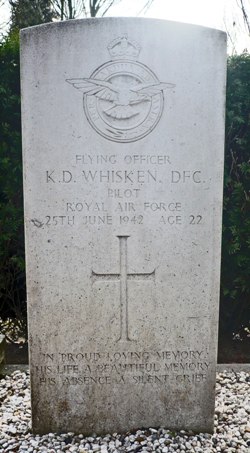Whitley Z6940 damaged by flak, returned to Topcliffe airfield.
On the night of 29th / 30th August 1941 the crew of this 102 Squadron aircraft were tasked with Ops to Frankfurt to bomb the main railway station.
This aircraft took off at 21.09hrs but was hit by flak over the target area. The pilot was able to return to Topcliffe and make a safe landing
at 05.57hrs. The crew are not believed to have been injured.
Pilot - P/O Kenneth Derek Whisken RAFVR (61037), of Bournemouth, Hampshire.
Second Pilot - Sgt Edward William Smith RCAF (R/62692).
Observer - Sgt Frank Henry Mylrea RCAF (R/58214), of Vistoria, Canada.
? - Sgt George Edward Thompson RAFVR (637513), of Dunbar, East Lothian.
? - Sgt Thomas Beatty Nisbet RAFVR (980458).
He was killed on 25th/26th June 1942 and is buried in Dalfsen General Cemetery, Holland and was twenty two years old. He was the pilot of Halifax
V9993 which was shot down on Ops to Bremen and crashed in Holland, the aircraft was on charge with 1652 Conversion Unit at the time of the loss and
this training unit was instructed to put up aircraft for a 1000 bomber raid which called for maximum effort. It is currently not known whether Whisken
was an instructor flying on this Op with other screened aircrew, or whether the crew were 102 Squadron personnel converting to fly the Halifax's at the
time but either way it is likely 1652 CU was called upon by HQ to put up their aircraft to make the bomber force larger. A number of other training
units lost many aircrew on this raid. Oddly CWGC give the date of 25th June for his death, where as W R Chorley quotes the time of the aircraft being
shot down as being just after 02.00hrs on 26th July 1942. Dutch air historian Stefan Hendriks kindly provided me with extra details regarding this loss
and the photograph of Whisken's grave. His research has found that after being hit by fire from a German night-fighter and the rear gunner was killed,
Whisken ordered the
rest of the crew to bale out just after midnight on the 26th. Whisken dropped the last incendiary bombs and jumped after the rest baled out. Unfortunatly
his parachute failed to open and he did not survive. He was found the following morning just outside Lemelerveld. The bomber crashed about 5km east of
where Whisken jumped with the body of the rear gunner found near Raalte, close to Luttenberg. I thank Mr Hendriks for this additional information and the photograph of the grave.
Kenneth Whisken received his commission on 18th January 1941 to the rank of P/O on probation. He completed his Tour with 102 Squadron and was awarded the
DFC (Gazetted 13th March 1942), and his rank is given on the Citation as being Pilot Officer, however he was promoted to F/O on 18th January 1942. The
Citation reads.."This officer has participated in sorties both as second pilot and as captain of aircraft. He has shown exceptional skill and determination
in pressing home his attacks at all time. P/O Whisken has attacked many important targets in Germany, including Hamburg, Mannheim, Frankfurt, Stettin and
Cologne. He has at all times set a courageous example."

George Thompson was lost on 16th December 1941 on Ops to Dunkirk in Whitley Z6973 which was hit by flak and the aircraft later crashed into the Channel.
He was twenty years old and is commemorated on the Runnymede Memorial.
Hugh Halliday's superb RCAF research adds additional information into Frank Mylrea's career. He was born in October 1920 in Victoria and after
enlisting in Vancouver in June 1940 and training he flew his first Op with 102 Squadron on 14th August 1941 to Hannover. Over a period of ten months
he completed 28 operational flights. He was later
awarded the DFC (Gazetted in August 1942), the Citation reads.. "This Warrant Officer has been flying on operations since August 1941 and has
completed 28 operational sorties against targets in enemy occupied territory. He is a navigator of exceptional merit and has at all times shown
the greatest keenness and utmost determination to bomb the targets. By careful planning with his captains and attention to detail before a trip,
and his coolness and skill during flight, he has undoubtedly contributed to the success of the missions in which he has taken part. His example has
been an inspiration to the rest of the squadron and I strongly recommend him for the award of
the Distinguished Flying Cross." Frank Mylrea returned to Canada and gained a degree as the University of British Columbia (a photograph
found on the internet shows him in the college basketball team in 1946). He later worked as a geological engineer
across Canada and America. He died in 1997.
Thomas Nisbet received his commission on 30th October 1941. As Acting F/Lt Nisbet was awarded the DFC with 51 Squadron in October 1944 but no
citation has yet been found. He survived the War and remained in the RAF Post-War and was granted a permanent RAF Commission as F/Lt in 1947. S/Ldr
Nisbet retired on 1st October 1959.
Whitley Z6940 was built to contract 106962/40 by Armstrong Whitworth Ltd. at Baginton and was awaiting collection on 23rd July 1941, it was taken
on charge by 102 Squadron at Topcliffe the following month. As a result of the flak damage on 30th August 1941 Cat.A/FB was recorded and the aircraft
was repaired on site and returned to the unit. On 15th February 1942 it was transferred to the newly reformed 161 Squadron at Newmarket for SOE duties.
On 20th September 1942 it failed to return from an SOE mission, crashing near Boulogne killing the crew of six.